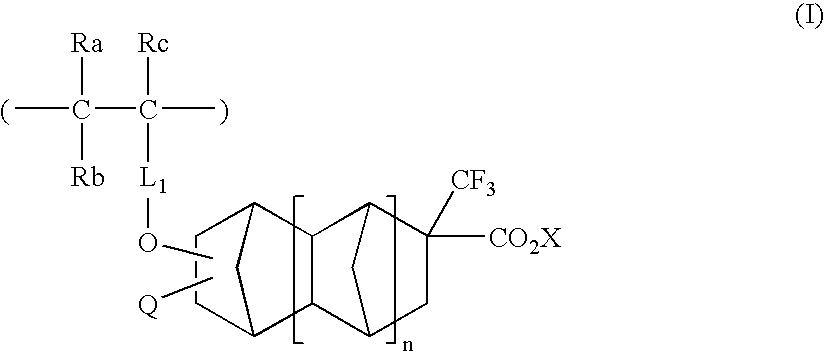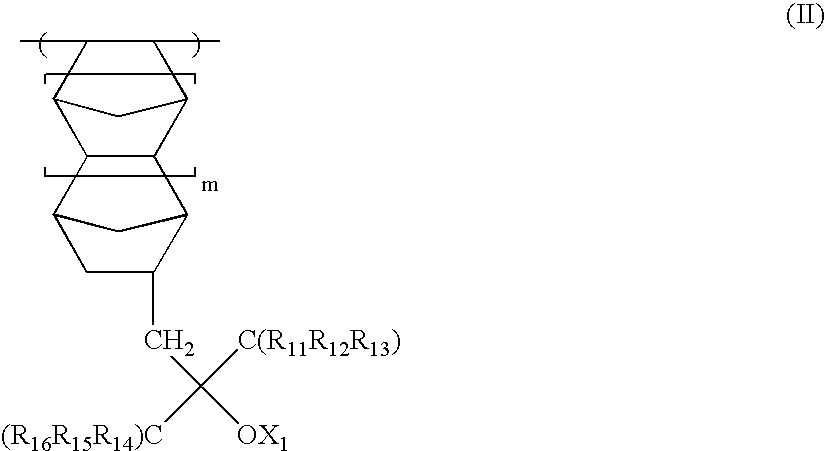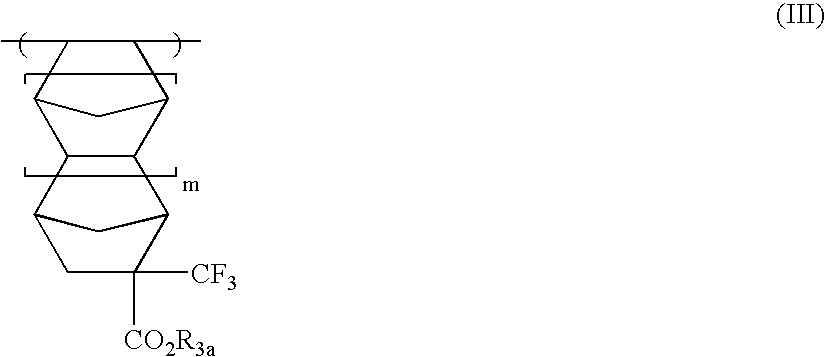Positive-working resist composition
- Summary
- Abstract
- Description
- Claims
- Application Information
AI Technical Summary
Benefits of technology
Problems solved by technology
Method used
Image
Examples
synthesis example 1-1 (
Synthesis of F-1)
[0537]To a mixture of 40.8 g of a monomer represented by the following formula (1) and 13.7 g of a monomer represented by the formula (2) which had been stirred in a nitrogen atmosphere was added 1.24 g of an azo-based polymerization initiator V-65 (produced by Wako Pure Chemical Industries, Ltd.). The mixture was then stirred at a temperature of 65° C. for 1 hour to undergo reaction. To the polymerization reaction solution which had been under reaction was then added dropwise a solution of 40.8 g of a separately prepared monomer represented by the following formula (1) and 13.7 g of a separately prepared monomer represented by the following formula (2) and 2.48 g of V-65 (produced by Wako Pure Chemical Industries, Ltd.) in 60 g of MEK which had been kept at 10° C. in 4 hours.
[0538]To the reaction solution was then added 500 ml of hexane to cause the precipitation of the polymer. The resulting upper layer was then removed by decantation. The remaining viscous polyme...
synthesis example 1-2
Synthesis of (F-1) by Living Radical Method
[0539]To a mixture of 40.2 g of the same monomer represented by the formula (1) in Synthesis Example 1 and 27.4 g of the same monomer represented by the formula (2) in Synthesis Example 1 which had been stirred in a nitrogen atmosphere were added 1.24 g of AIBN and 1.17 g of TEMPO (2,2,6,6-tetramethylpiperidinyl-1-oxy) as in Synthesis Example 1. The mixture was heated to a temperature of 80° C. where it was then reacted with stirring for 18 hours.
[0540]To the reaction solution was then added 500 ml of hexane to cause the precipitation of the polymer. The resulting upper layer was then removed by decantation. The polymer thus obtained was then measured for molecular weight by GPC. As a result, the polymer was found to have a weight-average molecular weight of 13,000 and a dispersion degree of 1.45.
[0541]Polymers having the above exemplified structures (F-2) to (F-6) were obtained in the same manner as Synthesis Example 1. The molar ratio, we...
synthesis example 1-3 (
Synthesis of Comparative Resin (C-1)
[0543]To a mixture of 27.5 g of the monomer of the formula (2) in Synthesis Example 1 and 19.6 g of t-butylester α-trifluoromethylacrylate which had been stirred in a nitrogen atmosphere was added 1.24 g of an azo-based polymerization initiator V-65 (produced by Wako Pure Chemical Industries, Ltd.). The mixture was then stirred at a temperature of 70° C. with stirring for 10 hours to undergo reaction.
[0544]To the reaction solution was then added 500 ml of hexane to cause the precipitation of the polymer. The resulting upper layer was then removed by decantation. The remaining viscous polymer was then dissolved in 50 ml of acetone. To the solution was then added 1 l of hexane to fractionate the polymer. The unreacted monomer and oligomer were then removed. The polymer thus obtained was then measured for molecular weight by GPC. As a result, the polymer was found to have a weight-average molecular weight of 8,100 and a dispersion degree of 1.9.
PUM
| Property | Measurement | Unit |
|---|---|---|
| Molar density | aaaaa | aaaaa |
| Molar density | aaaaa | aaaaa |
| Fraction | aaaaa | aaaaa |
Abstract
Description
Claims
Application Information
 Login to View More
Login to View More - R&D
- Intellectual Property
- Life Sciences
- Materials
- Tech Scout
- Unparalleled Data Quality
- Higher Quality Content
- 60% Fewer Hallucinations
Browse by: Latest US Patents, China's latest patents, Technical Efficacy Thesaurus, Application Domain, Technology Topic, Popular Technical Reports.
© 2025 PatSnap. All rights reserved.Legal|Privacy policy|Modern Slavery Act Transparency Statement|Sitemap|About US| Contact US: help@patsnap.com



